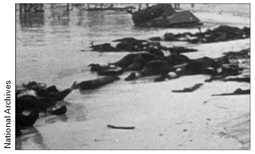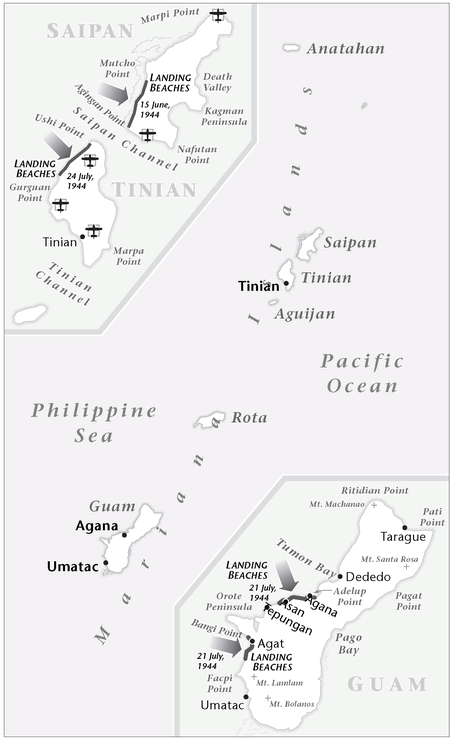War Stories II (47 page)
Authors: Oliver L. North

 THE WHITE HOUSE
THE WHITE HOUSEWASHINGTON, D.C.
17 DECEMBER 1943
1100 HOURS LOCAL
17 DECEMBER 1943
1100 HOURS LOCAL
Norm Hatch's award-winning documentary might never have been made except for an inadvertent release of some of the footage he and his assistant, Bill “Kelly” Kelleher, had shot during those four furious days. Their 16mm negatives, rushed back to the States by zealous public affairs officers, were supposed to be subject to clearance by military censors in Washington. But when the film reached San Francisco, instead of sending it directly on for clearance, black-and-white prints several minutes long were made selectively from Hatch's black-and-white reels and from Kelleher's color footage. Fox Movietone News then distributed hundreds of these black-and-white celluloid prints to local movie theaters. The agency was never told that government censors hadn't cleared the footage.
Â
U.S. Marine casualties at Tarawa.

Roosevelt was furious. The American people were stunned. On the eve of the holiday season, local movie screens were showing American war deadânot one or two, but hundreds. The Movietone narrator succinctly summed up the graphic images: “The battle of Tarawa is officially described as the most ferocious fight the Marines have ever been in. Each hour was terrifying with violence and gunfire and the hurling of grenades.”
Nimitz and Vandegriftânow the senior Marine in the Pacificâimportuned Admiral King, the chief of naval operations, that they had nothing to cover up and that the American people deserved to know the bitter truth about how difficult it was going to be to beat the Japanese. Roosevelt agreed, and the footage shot by Norm Hatch and Bill Kelleher was edited to produce the Academy Awardâwinning documentary
With the Marines at Tarawa
. And though enlistment in the Marines dropped by 35 percent for a few months, war bond sales increased dramatically.
With the Marines at Tarawa
. And though enlistment in the Marines dropped by 35 percent for a few months, war bond sales increased dramatically.
The lessons learned in seventy-six hours at Tarawa were almost all technical and resulted in changes that would make future amphibious assaults less costly, including the biggest one in Europe: Normandy. As a result of the losses at Tarawa, the Marines received hundreds of improved LVTs equipped with heavy guns and armor. The Navy developed LCMRsâlanding craft equipped with rocket launchers to provide heavy suppression fire just before the assault waves hit the beach. Better long-range waterproof radios were developed and fielded. Naval gunnery improved with new training, ammunition, and fuses. Marine and Navy carrier pilots were provided with better training and more lethal bombsâlike napalmâfor dealing with well-prepared defenses.
And for the Marines who would have to do it again and again and again all the way across the Pacific, the survivors of the 2nd Division's assault on Tarawa were sent as cadre to other Marine units to teach others the “lessons learned.” And wherever they went, those who fought at Tarawa were greeted with awe. As one survivor said, “Every participant became a hero in spite of himself.”

CHAPTER 12
ASSAULT ON THE MARIANAS
(JUNEâAUGUST 1944)
 HQ CENTRAL PACIFIC
HQ CENTRAL PACIFICPEARL HARBOR, HAWAII
11 JUNE 1944
11 JUNE 1944
A
fter the horrific bloodletting on Tarawa, Major General Holland M. Smith urged Nimitz to reconsider Operation Flintlockâthe invasion of the Marshall Islandsâscheduled for 1 February. The plan Nimitz had approved called for simultaneous landings on Maloelap, Wotje, and Kwajalein atolls. Smith, joined by Admirals Spruance and Turner, insisted that the central Pacific forces were inadequate to seize all three Japanese bases at the same time and that a protracted period of “softening up” the three targetsâwith sequential assaultsâwould yield the same results with fewer American casualties.
fter the horrific bloodletting on Tarawa, Major General Holland M. Smith urged Nimitz to reconsider Operation Flintlockâthe invasion of the Marshall Islandsâscheduled for 1 February. The plan Nimitz had approved called for simultaneous landings on Maloelap, Wotje, and Kwajalein atolls. Smith, joined by Admirals Spruance and Turner, insisted that the central Pacific forces were inadequate to seize all three Japanese bases at the same time and that a protracted period of “softening up” the three targetsâwith sequential assaultsâwould yield the same results with fewer American casualties.
Navy code-breakers and occasional long-range reconnaissance flights by PBYs flying from the Ellices, Tarawa, and Pearl Harbor confirmed what Smith, Turner, and Spruance feared. The Japanese had held the Marshalls since 1935 and were now hastily improving the defenses on all three atolls
and their other outlying bases in the Marshalls: Jaluit, Mili, and Majuro. By January, there were already 5,500 Japanese troops on Kwajalein atoll and more were on the way from the Marianas and the Home Islands. Tokyo apparently believed that the Americans intended to seize the Marshalls nextâand the Japanese planned to make any U.S. invasion as expensive as possible.
and their other outlying bases in the Marshalls: Jaluit, Mili, and Majuro. By January, there were already 5,500 Japanese troops on Kwajalein atoll and more were on the way from the Marianas and the Home Islands. Tokyo apparently believed that the Americans intended to seize the Marshalls nextâand the Japanese planned to make any U.S. invasion as expensive as possible.
Nimitz was already under pressure from Washington to advance his timetable for seizing the Marianas. The Joint Chiefs wanted to use the islands as a base for a new generation of long-range bombers now coming off production lines in the U.S. The big Boeing B-29 “Superfortresses,” with a 20,000-pound destructive potential that had no other rival in the air, could make the trip to Tokyo from the Marianas in under six hours.
Realizing that he would have to take the Marshalls before moving on to the Marianas, Nimitz countered his critics with a concept of operations that was even bolder than his original plan. The increasingly powerful 5th Fleet would simply bomb and isolate the Japanese garrisons on Wotje, Maloelap, Jaluit, and Mili and go straight for lightly defended Majuro and heavily protected Kwajalein atoll. Once these two bases were secured, the 5th Amphibious Force would seize Eniwetok.
This daring strategy notwithstanding, Operation Flintlock succeeded beyond anyone's expectations, save perhaps those of Nimitz himself. Starting in early January, Admiral John Hoover's land-based bombers, flying from the Ellice Islands and Tarawa, began systematic raids on all the Japanese bases in the Marshalls. Well before the end of the month, no Japanese aircraft remained east of the Marianas.
Meanwhile, Admiral Ray Spruance's 5th Fleetâmore than 350 ships, 700 carrier-based aircraft, and 53,000 assault shipsâwas deployed to conduct the invasion. A small Marine combat team would secure the lightly defended Majuro. The Army's 7th Infantry Division was tasked with taking Kwajalein, and the new, untested 4th Marine Division was assigned to seize Roi and Namur at the northern end of the Kwajalein atoll.
The Marines remembered the lessons learned at Tarawa: The islands of Roi, Namur, and Kwajalein were hit with more than 15,000 tons of bombs.
Then, for three days before the assault forces went ashore on 1 February, battleships and heavy cruisers battered the landing beaches and anything above ground on the target islands.
Then, for three days before the assault forces went ashore on 1 February, battleships and heavy cruisers battered the landing beaches and anything above ground on the target islands.
Hastily deployed Navy underwater demolition teams (UDTs) reconnoitered every beach. New armored amphibians equipped with 37 mm howitzers and machine guns took the assault waves across the coral reef and then ashore. LCMRs equipped with rockets and 40 mm cannons raked the landing beaches under covering fire from close-in destroyers. The USS
Appalachian
and USS
Rocky Mount
, recently arrived amphibious command ships standing close offshore, coordinated the landings and the delivery of supporting fire over new, more capable, waterproof radios used by the assault commanders.
Appalachian
and USS
Rocky Mount
, recently arrived amphibious command ships standing close offshore, coordinated the landings and the delivery of supporting fire over new, more capable, waterproof radios used by the assault commanders.
Though inadequate training and rehearsal marred the Marine landings on Roi and Namur, the Army assault on Kwajalein was flawlessly executed. And because nearly half the Japanese defenders were already dead from the massive preâH-Hour bombardment and shelling, all of the objectives were secured by 4 February. More than 5,000 Japanese were dead at a cost of 177 American lives and fewer than 900 wounded. Before the assault troops were completely backloaded, Seabee bulldozers and graders had the runways, taxiways, and aprons on Roi and Kwajalein fully operational.
The victory was so swift and lopsided that Nimitz urged Spruance to press his attack on Eniwetok without returning to Pearl Harbor for refit, rest, and replenishment. Spruance agreed and raised Nimitz one by dispatching Marc Mitscher and his Task Force 58 fast carrier groups to destroy the Japanese naval and air bases on Truk, the forward headquarters of the Imperial Combined Fleet. Spruance himself joined in the attack with his flagship, the brand new battleship
Iowa
, and her sister,
New Jersey
, accompanied only by two heavy cruisers, four destroyers, and ten submarines.
Iowa
, and her sister,
New Jersey
, accompanied only by two heavy cruisers, four destroyers, and ten submarines.
In thirty hours of coordinated nonstop air, surface, and underwater attacks starting at dawn on 17 February, the Americans sank fifteen Imperial Navy combatants and sent nineteen Japanese military cargo ships, five tankers, and more than fifty smaller vessels to the bottom. Mitscher's pilots, flying new radar-guided TBM-1C Avengers, Helldivers, Hellcats, and
Corsairs, destroyed over 230 Japanese aircraft at a cost of twenty-five U.S. planes. The carrier
Intrepid
, hit by a Japanese torpedo launched from a Nakajima B6N “Jill,” was the only American ship damaged, and she managed to limp back to Majuro for repairs.
Corsairs, destroyed over 230 Japanese aircraft at a cost of twenty-five U.S. planes. The carrier
Intrepid
, hit by a Japanese torpedo launched from a Nakajima B6N “Jill,” was the only American ship damaged, and she managed to limp back to Majuro for repairs.
While Trukâthe Gibraltar of the Pacificâwas being pummeled, Turner's 5th Amphibious Force assaulted Eniwetok atoll. The 22nd Marine Regiment quickly cleared its two objectivesâEngebi and Parry islandsâand then crossed the lagoon to assist the lesser-trained regiment of the 27th Infantry Division, which had become bogged down on Eniwetok Island. The entire atoll was declared secure on the afternoon of 20 February. Nimitz was now ready to take on a much tougher target 1,000 miles to the west, in the Emperor's back yard: the Marianas.

Other books
Henry Gallant Saga 2: Lieutenant Henry Gallant by H. Peter Alesso
OUR LAST NIGHT: an edge of your seat ghost story thriller by ADAMS, TAYLOR
Deeper by Mellie George
Summer of Supernovas by Darcy Woods
Virgin Wanted (BWWM Billionaire Romance) by Cole, Sierra
If Rock and Roll Were a Machine by Terry Davis
The Splendor of Ordinary Days by Jeff High
Billionaire Takes All by Jackson Kane
A Vengeful Affair by Carmen Falcone
Caiden (A MacLaughlin Family Novella Book 2) by Krystal Shannan
